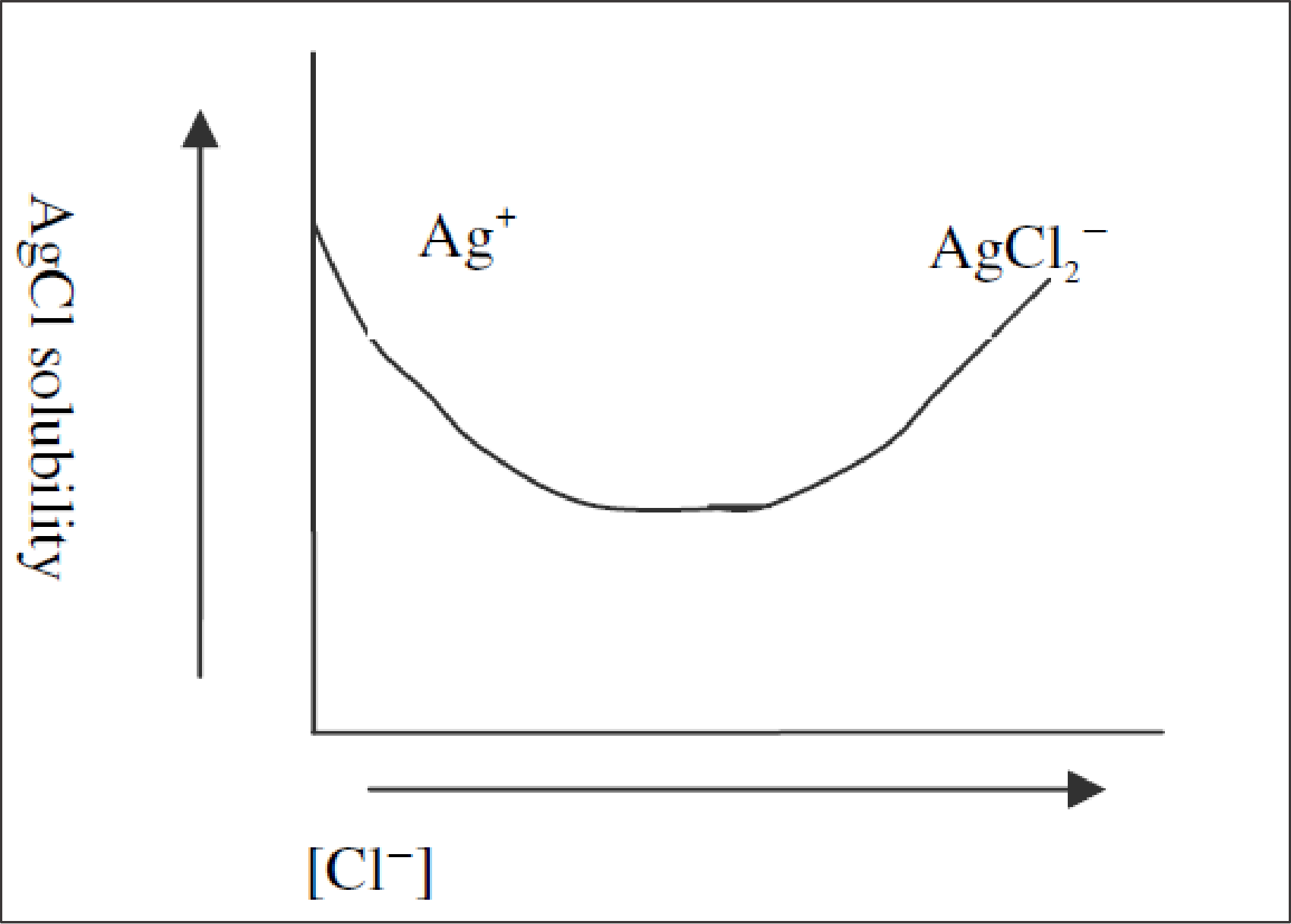
Concept explainers
(a)
Interpretation:
Concept introduction:
Solubility:
Solubility is defined as the maximum amount of the solute that can be dissolved in the solvent at equilibrium.
Solubility product constant:
Solubility product constant is defined for equilibrium between solids and its respective ions in the solution. Generally, solubility product refers only to insoluble or slightly soluble ionic substances that make equilibrium in water.
It is defined as the product of concentration of ions of a sparingly soluble salt in its saturated solution at
This value indicates the degree of dissociation of a compound in water. More the value of
Considering an equilibrium of salt
Formation constant:
A stability constant or formation constant is an equilibrium constant for the formation of a complex ion in the solution and it measures the strength of interaction between the reactants that forms the complex.
(a)
Answer to Problem 19.148P
It is proved that
Explanation of Solution
Given that the equations are,
Subtracting the above equation (1) from equation (2),
Substituting the value of
Therefore it is proved that
(b)
Interpretation:
Value of
Concept introduction:
Solubility:
Solubility is defined as the maximum amount of the solute that can be dissolved in the solvent at equilibrium.
Solubility product constant:
Solubility product constant is defined for equilibrium between solids and its respective ions in the solution. Generally, solubility product refers only to insoluble or slightly soluble ionic substances that make equilibrium in water.
It is defined as the product of concentration of ions of a sparingly soluble salt in its saturated solution at
This value indicates the degree of dissociation of a compound in water. More the value of
Considering an equilibrium of salt
Formation constant:
A stability constant or formation constant is an equilibrium constant for the formation of a complex ion in the solution and it measures the strength of interaction between the reactants that forms the complex.
(b)
Answer to Problem 19.148P
The value of
Explanation of Solution
Given that,
Now the condition is given that
From the formation constant,
Substituting the value of
Now according to given condition,
Therefore
(c)
Interpretation:
Plot of solubility of
Concept introduction:
Solubility:
Solubility is defined as the maximum amount of the solute that can be dissolved in the solvent at equilibrium.
Solubility product constant:
Solubility product constant is defined for equilibrium between solids and its respective ions in the solution. Generally, solubility product refers only to insoluble or slightly soluble ionic substances that make equilibrium in water.
It is defined as the product of concentration of ions of a sparingly soluble salt in its saturated solution at
This value indicates the degree of dissociation of a compound in water. More the value of
Considering an equilibrium of salt
Le Chatelier’s principle:
When a system in equilibrium then is subjected to any external disturbance like change of pressure, volume, temperature etc… Then the system acts in a way to prevent that change. This is called Le-Chatelier’s principle.
(c)
Explanation of Solution
Given that,
When the concentration of
As the
After that if
The graph is given below,

Figure.1
(d)
Interpretation:
The solubility of
Concept introduction:
Solubility:
Solubility is defined as the maximum amount of the solute that can be dissolved in the solvent at equilibrium.
Solubility product constant:
Solubility product constant is defined for equilibrium between solids and its respective ions in the solution. Generally, solubility product refers only to insoluble or slightly soluble ionic substances that make equilibrium in water.
It is defined as the product of concentration of ions of a sparingly soluble salt in its saturated solution at
This value indicates the degree of dissociation of a compound in water. More the value of
Considering equilibrium of salt
Formation constant:
A stability constant or formation constant is an equilibrium constant for the formation of a complex ion in the solution and it measures the strength of interaction between the reactants that forms the complex.
(d)
Answer to Problem 19.148P
The solubility of
Explanation of Solution
The condition given
From that it can be concluded that the value of
The condition is that solubility of
It is already found that,
Hence the solubility of
Want to see more full solutions like this?
Chapter 19 Solutions
Loose Leaf for Chemistry: The Molecular Nature of Matter and Change
- 个 Stuck x ctc xALE X A ALE × A ALE X Lab x (19: x - G www-awu.aleks.com/alekscgi/x/Isl.exe/10_u-lgNslkr7j8P3jH-1Q1g8NUi-mObka ZLx2twjEhK7mVG6PUUIO06 Chapter 12 HW 三 Question 26 of 39 (4 points) 1 Question Attempt: 1 of Unlimited Answer the following questions about the given alkane. Part: 0 / 2 Part 1 of 2 Give the IUPAC name. Skip Part 2 53°F Clear Check × Q Search hp hp 02arrow_forwardCalculate the equilibrium constant at 25.0 oC for the following equation. Cd(s) + Sn+2(aq) ↔Cd+2(aq) + Sn(s) Group of answer choices 3.11x104 1.95x1018 9.66x108 1.40x109arrow_forwardWhat is the pH at the cathode for the following cell written in line notation at 25.0 oC with a Ecell = -0.2749 V? Ni(s)|Ni+2(aq, 1.00 M)||H+1(aq, ?M)|H2(g, 1.00 atm)|Pt(s)arrow_forward
- Calculate Ecell for a hydrogen fuel cell at 95.0 oC using the following half-reactions with PH2 = 25.0 atm and PO2 = 25.0 atm. O2(g) + 4H+1(aq) + 4e-1 → 2H2O(l) Eo = 1.229 V 2H2(g) → 4H+1(aq) + 4e-1 Eo = 0.00 Varrow_forwardCalculate Ecell at 25.0 oC using the following half-reactions with [Ag+1] = 0.0100 M and [Sn+2] = 0.0200 M. Ag+1(aq) + 1e-1 Ag(s) Sn+2(aq) + 2e-1 Sn(s)arrow_forwardDone 18:19 www-awu.aleks.com Chapter 12 HW Question 27 of 39 (5 points) | Question Attempt: 1 of Unlimited .. LTE סוי 9 ✓ 20 ✓ 21 × 22 23 24 25 26 27 28 29 30 Answer the following questions about the given alkane. Part: 0 / 2 Part 1 of 2 Classify each carbon atom as a 1º, 2º, 3º, or 4°. Highlight in red any 1° carbons, highlight in blue any 2° carbons. highlight in green any 3° carbons, and leave any 4° carbons unhighlighted. Skip Part Check Save For Later © 2025 McGraw Hill LLC. All Rights Reserved. Terms of Use Privacy Center | Accessibility ☑ คarrow_forward
- < Done 19:22 www-awu.aleks.com Chapter 12 HW Question 4 of 39 (2 points) | Question Attempt: 5 of Unlimited : .. LTE סוי 1 ✓ 2 ✓ 3 = 4 ✓ 5 ✓ 6 ✓ 7 ✓ 8 ✓ 9 = 10 11 ✓ 12 Consider the molecule (CH3)2CHCH2CHCн for the following questions. Part 1 of 2 Which of the following molecules is/are constitutional isomer(s) to (CH3)2CHCH2CH2CH3? Check all that apply. Part 2 of 2 (CH3),C(CH2)2CH3 CH3 H,C-CH-CH-CH, CH 3 None of the above. ☑ Which of the following molecules is/are identical molecules to (CH3)2CHCH2CH2CH₁₂? Check all that apply. CH3 H,C-CH-CH₂-CH2-CH, CH3(CH2)2CH(CH3)2 CH2-CH2-CH3 HỌC-CH=CH, 乂 ☑ а None of the above Check Save For Later Submit Assignment © 2025 McGraw Hill LLC. All Rights Reserved. Terms of Use | Privacy Center Accessibilityarrow_forward18:11 LTE ا... US$50 off hotels is waiting for you Book now, hotels in Nashville are going fast QUTSLIVII 25 61 69 points) | QuestIVIT ALLēm... now Give the IUPAC name for each compound. Part 1 of 3 Part 2 of 3 X ☑ Х Check Save For Later Submit © 2025 McGraw Hill LLC. All Rights Reserved. TOMS CT US ...vacy Center | Accessibilityarrow_forwardDone 19:17 www-awu.aleks.com Chapter 12 HW Question 29 of 39 (6 points) | Question Attempt: 1 of Unlimited .III LTE סוי 27 28 = 29 30 31 32 = 33 34 35 Consider this structure. CH3CH2CH2 Part 1 of 3 3 CH2 CH2CH3 - C-CH2CH 3 H CH₂ Give the IUPAC name of this structure. 3-ethyl-3,4-dimethylheptane Part: 1/3 Part 2 of 3 Draw the skeletal structure. Skip Part < Check Click and drag to start drawing a structure. Save For Later Submit © 2025 McGraw Hill LLC. All Rights Reserved. Terms of Use | Privacy Center | Accessibility Хarrow_forward
- 18:57 .III LTE www-awu.aleks.com Chapter 12 HW Question 31 of 39 (8 points) | Question Attem... Give the IUPAC name of each compound. Part 1 of 4 Part 2 of 4 Х Х Check Save For Later Submit © 2025 McGraw Hill LLC. All Rights Reserved. TOMS OF US vacy Center | Accessibilityarrow_forwardWhat is the missing reactant in this organic reaction? CH3-C-CH2-NH2 + R - CH3 O: 0 CH3-N-CH2-C-NH-CH2-C-CH3 + H2O Specifically, in the drawing area below draw the condensed structure of R. If there is more than one reasonable answer, you can draw any one of them. If there is no reasonable answer, check the No answer box under the drawing area. Note for advanced students: you may assume no products other than those shown above are formed. Explanation Check Click anywhere to draw the first atom of your structure. C © 2025 McGraw Hill LLC. All Rights Reserved. Terms of Use | Privacy Center Accesarrow_forwardDone 18:17 • www-awu.aleks.com Chapter 12 HW Question 24 of 39 (4 points) | Question Attempt: 1 of Unlimited ▼ 20 ✓ 21 × 22 23 24 25 26 raw the structure corresponding to each IUPAC name. Part 1 of 2 .III LTE 22 27 28 סוי 29 29 3 A skeletal structure corresponding to the IUPAC name 3-ethyl-4-methylhexane. Part 2 of 2 Click and drag to start drawing a structure. A condensed structure corresponding to the IUPAC name 2,2,4- trimethylpentane. Click anywhere to draw the first atom of your structure. Check Save For Later Submit < Х ப: G © 2025 McGraw Hill LLC. All Rights Reserved. Terms of Use | Privacy Center | Accessibility : Garrow_forward
 ChemistryChemistryISBN:9781305957404Author:Steven S. Zumdahl, Susan A. Zumdahl, Donald J. DeCostePublisher:Cengage Learning
ChemistryChemistryISBN:9781305957404Author:Steven S. Zumdahl, Susan A. Zumdahl, Donald J. DeCostePublisher:Cengage Learning ChemistryChemistryISBN:9781259911156Author:Raymond Chang Dr., Jason Overby ProfessorPublisher:McGraw-Hill Education
ChemistryChemistryISBN:9781259911156Author:Raymond Chang Dr., Jason Overby ProfessorPublisher:McGraw-Hill Education Principles of Instrumental AnalysisChemistryISBN:9781305577213Author:Douglas A. Skoog, F. James Holler, Stanley R. CrouchPublisher:Cengage Learning
Principles of Instrumental AnalysisChemistryISBN:9781305577213Author:Douglas A. Skoog, F. James Holler, Stanley R. CrouchPublisher:Cengage Learning Organic ChemistryChemistryISBN:9780078021558Author:Janice Gorzynski Smith Dr.Publisher:McGraw-Hill Education
Organic ChemistryChemistryISBN:9780078021558Author:Janice Gorzynski Smith Dr.Publisher:McGraw-Hill Education Chemistry: Principles and ReactionsChemistryISBN:9781305079373Author:William L. Masterton, Cecile N. HurleyPublisher:Cengage Learning
Chemistry: Principles and ReactionsChemistryISBN:9781305079373Author:William L. Masterton, Cecile N. HurleyPublisher:Cengage Learning Elementary Principles of Chemical Processes, Bind...ChemistryISBN:9781118431221Author:Richard M. Felder, Ronald W. Rousseau, Lisa G. BullardPublisher:WILEY
Elementary Principles of Chemical Processes, Bind...ChemistryISBN:9781118431221Author:Richard M. Felder, Ronald W. Rousseau, Lisa G. BullardPublisher:WILEY





